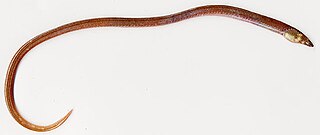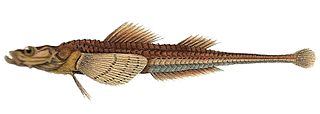 W
WThe armless snake eel is an eel in the family Ophichthidae. It was described by François Étienne Delaroche in 1809. It is a subtropical, marine eel which is known from the eastern Atlantic Ocean, including Spain, Mauritania, and the Mediterranean. It dwells at a depth range of 20–80 metres, and forms burrows in mud or sand. Males can reach a maximum total length of 150 centimetres.
 W
WThe bandtooth conger, also known as the Baleares conger or the Balearic conger, is an eel in the family Congridae. It was described by François Étienne Delaroche in 1809, originally under the genus Muraena. It is a subtropical, marine eel which is known from the western and eastern Atlantic and the western Indian Ocean, including North Carolina, USA; the northern Gulf of Mexico, northern South America, Canada, Portugal, Angola, the Mediterranean, and the Red Sea. It inhabits reefs and littoral shelves, and burrows into sand and mud. It dwells at a depth range of 1–732 metres, but most frequently between 20–100 m. Males can reach a maximum total length of 35 centimetres, but more commonly reach a TL of 25 cm.
 W
WThe blackbelly rosefish, Helicolenus dactylopterus, is a marine bony fish from the family Sebastidae, also known as bluemouth rockfish, and bluemouth seaperch. This Atlantic species is a typical sit-and-wait predator with a highly cryptic coloration.
 W
WBothus podas, also known as the wide-eyed flounder, is a flounder in the genus Bothus, native to the Mediterranean Sea and the Atlantic Coast of Africa.
 W
WBrachyopsis segaliensis is a species of poacher native to the northwest Pacific Ocean where it is found at depths of from 0 to 110 metres. This species grows to a length of 30 centimetres (12 in) TL. This species is the only known member of its genus.
 W
WThe brown moray eel, Gymnothorax unicolor, is a moray eel found in the eastern Atlantic Ocean and Mediterranean. It was first named by Delaroche in 1809.
 W
WHeterobranchus bidorsalis, the African catfish or eel-like fattyfin catfish, is an airbreathing catfish found in Africa. It is closely related to the vundu catfish, which is well-known among fishermen.
 W
WParamonacanthus japonicus is a filefish from the Indo-West Pacific. It occasionally makes its way into the aquarium trade. It grows to a size of 12 cm in length.
 W
WCallionymus pusillus, the Sailfin dragonet, is a species of dragonet common in the Eastern Atlantic, where it occurs on the Portuguese coast to as far north as Lisbon and south to Morocco, and also in the northern Mediterranean including the Adriatic, Aegean and Black seas as well as the coastsLebanon and Israel. It occurs on the southern Mediterranean shore as far east as Tunisia Males of this species grows to a length of 14 centimetres (5.5 in) TL while females reach a length of 10 centimetres (3.9 in) TL. In the areas of the Mediterranean where it occurs it is one of the commonest dragonet species, as it is the only species that has been recorded within many protected areas. It is a benthic species which occurs in shallow waters and prefers sandy bottoms down to 100 metres (330 ft). The males are territorial, aggressively defend their territories from other males and like other dragonets this species undergoes complex breeding behaviour which has 4 phases. This starts with courtship, the male and female then form a pair before ascending to the surface where they release eggs and milt. The spawning season runs from May to August in the Mediterranean and the eggs and larvae are pelagic. This species feeds mainly on small benthic invertebrates such as worms and small crustaceans.
 W
WSynodontis membranaceus, known as the moustache catfish, is a species of upside-down catfish that is native to northern Africa. It was first described by French naturalist Geoffroy Saint-Hilaire in 1809 as Pimelodus membranaceus, from specimens obtained in the Nile River. The species name membranaceus refers to membranes present on the barbels of the fish.
 W
WThe Thinlip conger is an eel in the family Congridae. It was described by François Étienne Delaroche in 1809, originally under the genus Muraena. It is a subtropical, marine eel which is known from the eastern Atlantic Ocean, including southern Portugal, the Mediterranean, and Morocco. It dwells at a depth range of 75–800 metres, and inhabits mud and sand on the continental slope. Males can reach a maximum total length of 60 centimetres, but more commonly reach a TL of 35 centimetres.